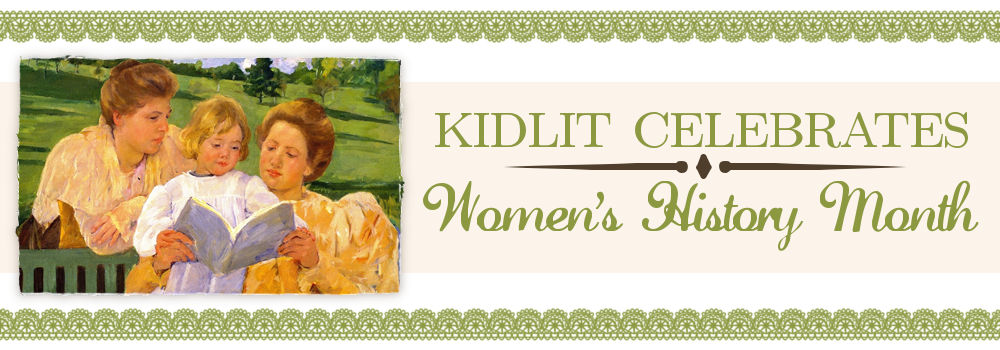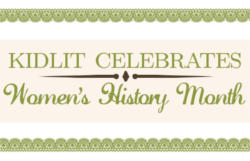March 7- Today's post contributed by Jan Pinborough
I had two goals in writing Miss Moore Thought Otherwise. The first was to let children know how they came to receive that indispensable yet much-taken-for-granted gift, the children’s library. Poet Walter de la Mare offered the best assessment of Moore’s towering contribution: “The children of this world will never be able to repay the debt they owe to [Anne Carroll Moore].” I thought that children deserved to know something about those whose vision and determination gave them the privileges of libraries and books. Along the way, I hoped to encourage “otherwise-thinking” children to value and pursue their own individualistic ideas––and thus to make their own unique contributions to the world.
.jpg)
“Miss Moore,” as Anne Carroll Moore was known at the NYPL, rejected the prevailing practices and attitudes of her time. And she labored tirelessly to create a new model of library service for children that helped transform libraries around the country—and in many countries around the world.
The foundation of Moore’s transformative work was embodied in a creed she called “the Four Respects.”:
Anne Carroll Moore: Library Heroine
 |
Anne Carroll Moore
In 1911, just two years before the iconic march for women’s suffrage took place in front of the U.S. Capitol, another woman-inspired revolution was quietly taking shape behind the lions at the New York Public Library and in other libraries around the country. One of the leading heroines of that revolution was Anne Carroll Moore, the New York Public Library’s Superintendent of the Department of Work with Children. Today we consider a library filled with excellent books for children to be almost a basic right of childhood. So it’s shocking to think of a time when children under 14 were forbidden to enter libraries. Or when librarians kept children’s books behind glass, and when most saw their roles as protecting books from children, rather than making books available to children. Yet such was the state of library service around the turn of the century—until Anne Carroll Moore and other trailblazing women librarians—refused to accept the status quo. |
I had two goals in writing Miss Moore Thought Otherwise. The first was to let children know how they came to receive that indispensable yet much-taken-for-granted gift, the children’s library. Poet Walter de la Mare offered the best assessment of Moore’s towering contribution: “The children of this world will never be able to repay the debt they owe to [Anne Carroll Moore].” I thought that children deserved to know something about those whose vision and determination gave them the privileges of libraries and books. Along the way, I hoped to encourage “otherwise-thinking” children to value and pursue their own individualistic ideas––and thus to make their own unique contributions to the world.
.jpg)
“Miss Moore,” as Anne Carroll Moore was known at the NYPL, rejected the prevailing practices and attitudes of her time. And she labored tirelessly to create a new model of library service for children that helped transform libraries around the country—and in many countries around the world.
The foundation of Moore’s transformative work was embodied in a creed she called “the Four Respects.”:
1) Respect for children as individuals. Moore visited each branch of the library, encouraging librarians to take down “Silence” signs and to spend more time talking with children. From her acute memory of her own childhood, as well as her “listening tour” around the kindergartens, settlement houses, and neighborhoods of New York City, she understood that children need books and beauty—and she filled the NYPL Central Children’s Room with both. Under her direction, paintings by N.C. Wyeth and Randolph Caldecott hung on the walls. She filled the Children’s Room with flowers for the nature-starved children of New York and set collections of shells and butterflies on child-sized tables made by Italian craftsmen. Reading clubs, puppet shows, and readings by the likes of Carl Sandburg, Ludwig Bemelmans, and Walter de la Mare brought books to life. Most important, Moore extended borrowing rights to every child who would pledge to properly care for the books with which they were entrusted.
Moore did not singlehandedly create the children’s library as we know it today. But her unique combination of intelligence, imagination, and ambition—coupled with her connections with authors, illustrators, and publishers and her situation at the iconic New York Public Library—gave her an especially wide-ranging influence in the development of children’s library services throughout the country and around the world.
Moore believed in the rights and dignity of all children, not just a privileged few. She made sure the library had books in many languages so that children who had recently come to this country could read books in their native languages. The library was a haven for children whose parents spent their days working to earn a livelihood in a new land. Moore used her famous Nicholas doll at least in part to help shy children who didn’t speak English well feel more comfortable talking. My book’s refrain, “Miss Moore thought otherwise, alludes to many opinions and attitudes that were very forward thinking, if not outright revolutionary.
2) Respect for children’s books. Moore fought for more and better books for children. She championed the genre and wrote many book reviews that appeared in the Horn Book, Bookman, and the New York Herald Review. Her famous opposition to Stuart Little was rooted in her philosophy that mixing fact and fantasy was not appropriate in books for children.
3) Respect for fellow workers. Notable authors Marcia Brown and Eleanor Estes worked with Moore in the NYPL before they launched their celebrated careers. When the king and queen of Belgium toured the library, Moore stepped in front of the procession and informed them that the Children’s Room was not to be missed.
4) Respect for the professional standing of children’s librarians. Moore encouraged the recognition of children’s librarianship as a professional specialty.
2) Respect for children’s books. Moore fought for more and better books for children. She championed the genre and wrote many book reviews that appeared in the Horn Book, Bookman, and the New York Herald Review. Her famous opposition to Stuart Little was rooted in her philosophy that mixing fact and fantasy was not appropriate in books for children.
3) Respect for fellow workers. Notable authors Marcia Brown and Eleanor Estes worked with Moore in the NYPL before they launched their celebrated careers. When the king and queen of Belgium toured the library, Moore stepped in front of the procession and informed them that the Children’s Room was not to be missed.
4) Respect for the professional standing of children’s librarians. Moore encouraged the recognition of children’s librarianship as a professional specialty.
Today as many libraries have fallen on hard times, and as some people even question their continuing relevance, I hope my book will encourage people will rise up in the support of libraries. In an increasingly digital age, we need once again to take up the cause of this great democratizing institution so that all children, not just the privileged, can continue to have access to the best books. To this end, people who visit my book’s website (www.missmoorethoughtotherwise.com) will soon be able to post their own memories of important books and libraries in their lives.
How grateful I am to the indomitable Anne Carroll Moore for helping make libraries all over the world more welcoming places for children, for passionately championing children's books, and most of all for extending to children the essential privilege of borrowing books.
This month we celebrate Stanton, Addams, Paul, and the other heroines who opened voting booths to women. Let’s also pause to remember Anne Carroll Moore and her heroic librarian sisters—Stearns, Hewins, Hunt, and others—who devoted their professional lives to swinging library doors open wide for children everywhere!
Jan Pinborough spent many delightful hours in the New York Public Library, poring over letters in the Anne Carroll Moore Collection, including a Christmas card from Beatrix Potter with a tiny hand-drawing of Moore’s famous Nicholas doll, a poem about Moore typewritten and sent by Carl Sandburg, notes from Theordore Geisel, and a congratulatory telegram from Eleanor Roosevelt. She remembers the children’s library from her childhood and the magical sense of walking into a space that felt like her very own. She lives in Salt Lake City, Utah, with her family. This is her first children’s book. Visit her websites www.missmoorethoughtotherwise.com and www.janpinborough.com.















I've been to NYPL Central Children's Room, but I did not know the story of Anne Carroll Moore, though I feel that I should have! Thanks so much for sharing your book and your research. I can't wait to read it and I'll be sure to visit the book's website! Thanks, Lisa
ReplyDeleteKids need books and beauty. What a great story (and blog post). Sounds like a wonderful book. Thank you for writing!
ReplyDeleteI love stories about librarians and what they have done for their communities! They are our unsung heroes and I'm so glad some are getting the long overdue recognition they deserve. Hooray for Women's History Month via KidLit Celebrates!
ReplyDeleteShe's really amazing. She had been a teacher, writer as well as suggest with regard to children's libraries. From 1906 to be able to 1941 she went childrens library solutions for the New York Public Library system. Moore wrote Nicholas, A new Long island Christmas time Tale, one of two runners-up for the 1925 Newbery Medal.
ReplyDeleteartist advance
I'm eager to reveal this page. I have to thank you for ones time for this especially awesome read!! 토토사이트링크
ReplyDelete